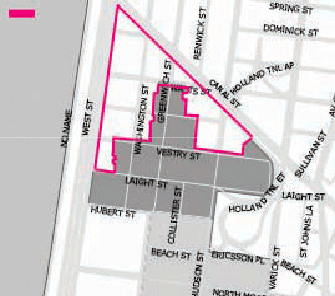By Julie Shapiro
In northwestern Tribeca, the buildings span two centuries. Crumbling brick homes and corniced warehouses stand among more modern structures. Over time, developers replace the old with the new, a cycle Community Board 1 is hoping to stop.
C.B. 1 is seeking to landmark the northwestern corner of Tribeca, which was left out when the rest of North Tribeca was landmarked in 1992. The V-shaped swatch, a roughly 10-block area, is bordered by Canal and West Sts. and extends south to Laight St. and east almost to the Holland Tunnel entrance.
“It’s long overdue,” said Roger Byrom, chairperson of the Landmarks Committee, in a phone interview. “This is completing unfinished business, really.”
Carole DeSaram, chairperson of the C.B. 1 Tribeca Committee, helped lead the 10-year effort to get the North Tribeca Historic District in 1992. The inclusion of the rest of North Tribeca would unify the neighborhood, she said.
continued below picture
459-463 Greenwich St., built in the late 19th century, would be protected if the district were extended.
continued from above picture:
“It’ll keep the texture together, the lines, the continuity,” DeSaram said in a phone interview. “You cannot have monstrous glass-fronted buildings next to buildings built prior to 1900. It just doesn’t look right — it just doesn’t work.”
Basha Estroff, a Columbia University urban planning student who works for the board through the borough president’s fellowship program, put together a presentation on the landmarking. The idea received unanimous approval at the Landmarks Committee last week. Estroff’s presentation, based in part on DeSaram and board member Andy Neale’s research, will go to the Landmarks Preservation Commission, which will make the final decision.
In her presentation to the Landmarks Committee, Estroff divided northwestern Tribeca’s development into four major periods, beginning with the early 19th century. The brick, utilitarian buildings from this period show “rational design with an emphasis on structural quality,” Estroff said. A three-story brick building at 437 Washington St., sandwiched between two taller buildings, fits this mold perfectly and also has an arched window, which is characteristic of the period.
In the late 19th century, the neighborhood saw many new warehouses for the paper and soap industries and for food processors. The white-stone, corniced structures, like the seven-story building at 459-463 Greenwich St., are characterized by cast-iron storefronts. The Greenwich St. building represents a “first-class commercial store,” in terms of the quality of design and construction, Estroff said.
A building doesn’t have to be beautiful to be worth preserving, Estroff said. Some pictures she showed of buildings from the early to mid 20th century, like the truck and auto shop repair shop at 276-277 West St., elicited grimaces from the board.
“They’re not the prettiest,” Estroff acknowledged, but she said they represent an important shift, not just in Tribeca but also in the entire city: the emergence of the automobile.
As an example of a building from the mid-20th century, Estroff showed an unpalatable yellow warehouse at 278-280 West St., which was torn down so Jack Parker Corp. could build condos. Although the warehouse was “not as aesthetically pleasing as some of the store-and-loft buildings of the late 19th century, [it] was certainly representative of the neighborhood’s history,” Estroff said.
Estroff estimates that 65 percent of the parcels in northwest Tribeca have historical buildings. The rest are either vacant or have modern or “noncontributing” buildings.
“That could be an issue — it was last time,” Estroff said, referring to the Landmarks Preservation Commission’s decision to exclude northwest Tribeca 16 years ago.
Since 1992, the district has lost both contributing and noncontributing buildings, said Michael Levine, director of land use and planning for C.B. 1.
“It’s a miracle that many of the buildings are still intact,” Byrom said. In the area near Tribeca South, another historic district the board had hoped to extend, hardly any historic buildings remain unaltered, he said. “We want to not allow the same thing to happen in the north,” Byrom added.
Landmarks Committee members were so enthusiastic about the landmarking application that they asked Estroff to start working on applications for south, central and west Tribeca.
The Landmarks Preservation Commission might not go for the whole thing, but “something is better than nothing,” board member Rick Landman said.
A possible obstacle to the landmarking is the number of “soft sites” in the neighborhood, lots that are either undeveloped or underdeveloped. But landmarking the district wouldn’t prevent new development, Levine said — it would just mean that all new buildings would have to come before the Landmarks Preservation Commission.
“We’re pro-development, just appropriate development,” Byrom said.
Estroff thinks there are enough historic buildings to make a good case for landmarking, and Levine agrees. The L.P.C. did not return a call for comment.
Julie@DowntownExpress.com





































